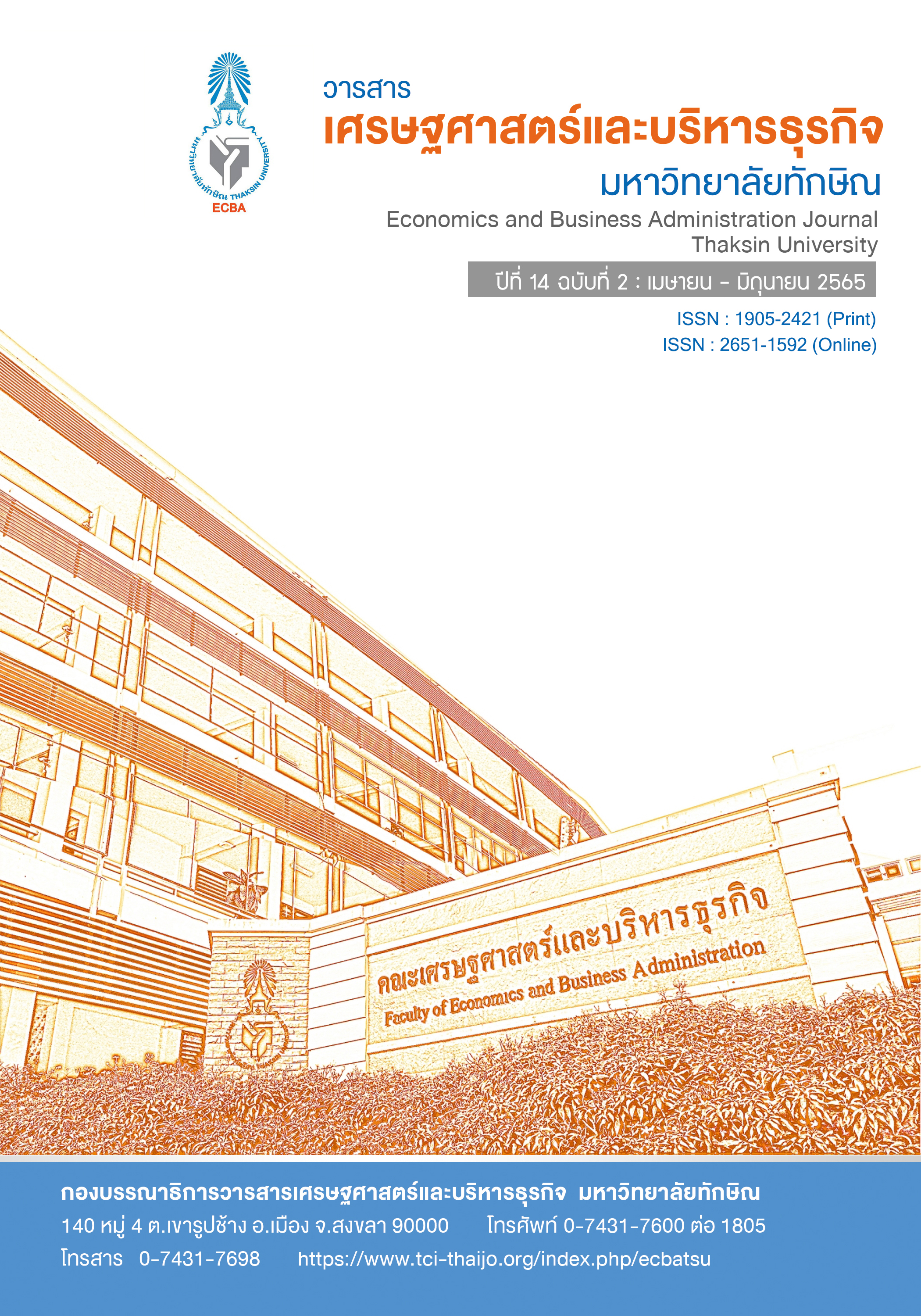คุณลักษณะของนวัตกรรมและการยอมรับเทคโนโลยีที่ส่งผลต่อความตั้งใจใช้งานแอปพลิเคชันซื้อสินค้าออนไลน์
คำสำคัญ:
คุณลักษณะของนวัตกรรม, ความตั้งใจใช้งานเทคโนโลยี, การยอมรับเทคโนโลยีบทคัดย่อ
การวิจัยนี้มีวัตถุประสงค์เพื่อศึกษาคุณลักษณะของนวัตกรรมและการยอมรับเทคโนโลยีที่ส่งผลต่อความตั้งใจใช้งานแอปพลิเคชันซื้อสินค้าออนไลน์ กลุ่มตัวอย่าง คือ ลูกค้าที่เคยซื้อสินค้าออนไลน์ผ่านแอปพลิเคชัน จำนวน 400 คน เครื่องมือที่ใช้ คือ แบบสอบถามออนไลน์ สถิติที่ใช้ในการวิเคราะห์ข้อมูล ได้แก่ ค่าความถี่ ค่าร้อยละ ค่าเฉลี่ย ค่าเบี่ยงเบนมาตรฐาน และการวิเคราะห์การถดถอยพหุคูณ ผลการวิจัย พบว่า คุณลักษณะของนวัตกรรม ซึ่งประกอบด้วย ความเข้ากันได้ การสังเกตได้ และการยอมรับเทคโนโลยี ประกอบด้วย การรับรู้ความง่าย เป็นปัจจัยที่ส่งผลต่อความตั้งใจใช้งานแอปพลิเคชันซื้อสินค้าออนไลน์ สามารถอธิบายความแปรปรวนร่วมของความตั้งใจใช้งานแอปพลิเคชันซื้อสินค้าออนไลน์ได้ร้อยละ 68.10 อย่างมีนัยสําคัญทางสถิติที่ระดับ 0.05 ผู้ประกอบการ ผู้บริหาร และนักการตลาดธุรกิจค้าปลีกรูปแบบดั้งเดิมและรูปแบบออนไลน์สามารถนำผลการวิจัยไปใช้เป็นแนวทางการพัฒนาแอปพลิเคชันซื้อสินค้าออนไลน์ให้สามารถบริการลูกค้าได้ตรงตามความต้องการและมีประสิทธิภาพมากยิ่งขึ้น โดยคำนึงถึงคุณลักษณะของนวัตกรรมด้านการสังเกตได้และความเข้ากันได้ และการยอมรับเทคโนโลยีด้านการรับรู้ความง่ายในการใช้งานแอปพลิเคชันของลูกค้า
เอกสารอ้างอิง
Chan-Olmsted, S., Rim, H., & Zerba, A. (2013). Mobile news adoption among young adults: examining the roles of perceptions, news consumption, and media usage. Journalism & Mass Communication Quarterly, 90(1), 126-147.
Choshaly, S.H. (2019). Applying Innovation Attributes to Predict Purchase Intention for the Eco-labeled Products: A Malaysian Case Study. International Journal of Innovation Science. 11(9), 583-599.
Chouyboonchoo, N. Sirichote, O., & Noknoi C. (2019). Effects of Technology acceptance and service quality on customer loyalty for electronic banking. Economics and Business Administration Journal, Thaksin University. 11(1), 31-52.
Cochran, W.G. (1997). Sampling Techniques (3rd ed.). New York: John Willey & Sons.
Davis, F. D. (1989). Perceived Usefulness, Perceived Ease of Use, and User Acceptance of Information Technology. MIS Quarterly. 13(3), 319-340.
Davis, F. D., Bagozzi, R. P., & Warshaw, P. R. (1989). User Acceptance of Computer Technology: A Comparison of Two Theoretical Models. Management Science. 35(8), 982-1003.
Electronic Transactions Development Agency. (2020). Thailand Internet User Behavior 2020. Retrieved from https://www.etda.or.th/th/Useful-Resource/publications/Thailand-Internet-User-Behavior-2020.aspx
Faqih, K. M., & Jaradat, M, R. (2015). Assessing the Moderating Effect of Gender Differences and Individualism-collectivism at Individual-level on the Adoption of Mobile Commerce Technology: TAM3 Perspective. Journal of Retailing and Consumer Services. 22(1), 37-52.
Fishbein, M., & Ajzen, I. (1975). Belief, Attitude, Intention and Behavior: An Introduction to Theory and Research. Reading, MA: Addison-Wesley.
He, Q. Duan, Y, Fu, Z., & Li, D. (2006). An Innovation Adoption Study of Online E-payment in Chinese Companies. Journal of Electronic Commerce in Organizations. 4(1), 48-69.
Kanjanawasee, S. (2001). Classical Test Theory (4th ed.). Bangkok: Chulalongkorn University Printing House.
Ketkaew, K., Potipiroon, W., & Srimai, W. (2020). Literature Review on the Factors Influencing
the Adoption of Mobile Applications. Journal of Management Sciences. 37(1), 163 -186.
Kongpetch, A., Vierraand, T., & Khongmalai, O. (2012). Adoption of SAP B1: A Case Study of Procurement Management in Non-Profit Organization. Master Degree in Thesis in Education, Thammasat University.
Namahoot, K.S. (2018). An analysis of Digital Banking Adoption Using Diffusion of Innovation Theory. Warasan Phuettikammasat. 24(2), 43-64.
Park, S.Y. (2009). An Analysis of the technology acceptance model in understanding university students’ behavioral intention to use e-learning. Educational Technology & Society, 12(3), 150-162.
Rogers, E. M. (2010). Diffusion of Innovations (5th ed.). New York: Simon and Schuster.
Sirichote, O. (2021). Technology Acceptance of Small and Medium Enterprises (SMEs) in Songkhla, Thailand. Princess of Naradhiwas University Journal of Humanities and Social Sciences. 8(2), 1-15.
Sukwadi, R., Caroline, L.S., & Chen, G.Y. (2022). Extended Technology Acceptance Model for Indonesian Mobile Wallet: Structural Equation Modeling Approach. Engineering and Applied Science Research. 49(2):146-154.
Vanichbuncha, K. (2019). Advanced Statistics Analysis by SPSS for Windows. (14thed.). Bangkok: Chulalongkorn University Printing House.
Venkatesh, V., Morris, M.G., Davis, G., & Davis, F.D. (2003). User Acceptance of Information Technology: Toward a Unified View. MIS Quarterly. 27(3), 425-78.
ดาวน์โหลด
เผยแพร่แล้ว
รูปแบบการอ้างอิง
ฉบับ
ประเภทบทความ
สัญญาอนุญาต
ลิขสิทธิ์ (c) 2022 วารสารเศรษฐศาสตร์และบริหารธุรกิจ มหาวิทยาลัยทักษิณ

อนุญาตภายใต้เงื่อนไข Creative Commons Attribution-NonCommercial-NoDerivatives 4.0 International License.




